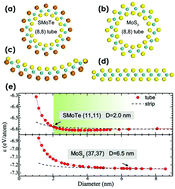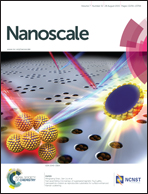Ultra-stable small diameter hybrid transition metal dichalcogenide nanotubes X–M–Y (X, Y = S, Se, Te; M = Mo, W, Nb, Ta): a computational study†
Abstract
Similar to graphene and hexagonal boron nitride (h-BN), the two-dimensional (2D) transition metal dichalcogenide (TMD) can be rolled into one-dimensional (1D) nanotubes. While, owing to their three-atom-thick structure, the large energy penalty greatly hinders the synthesis of small diameter TMD nanotubes. Here we propose the synthesis of hybrid TMD nanotubes with different chalcogens on each side (X–TM–Y) by self-assembly rolling up. Our calculations indicate that the tube formation can be driven by the relaxation of the intrinsic strain in X–TM–Y and the synthesis of the small hybrid nanotubes with diameter of ∼2.0 nm is possible. The rich variety of polymorphs exhibit unique and tunable electronic properties. Our finding opens a door synthesize hybrid small diameter TMD nanotubes for various applications.


 Please wait while we load your content...
Please wait while we load your content...